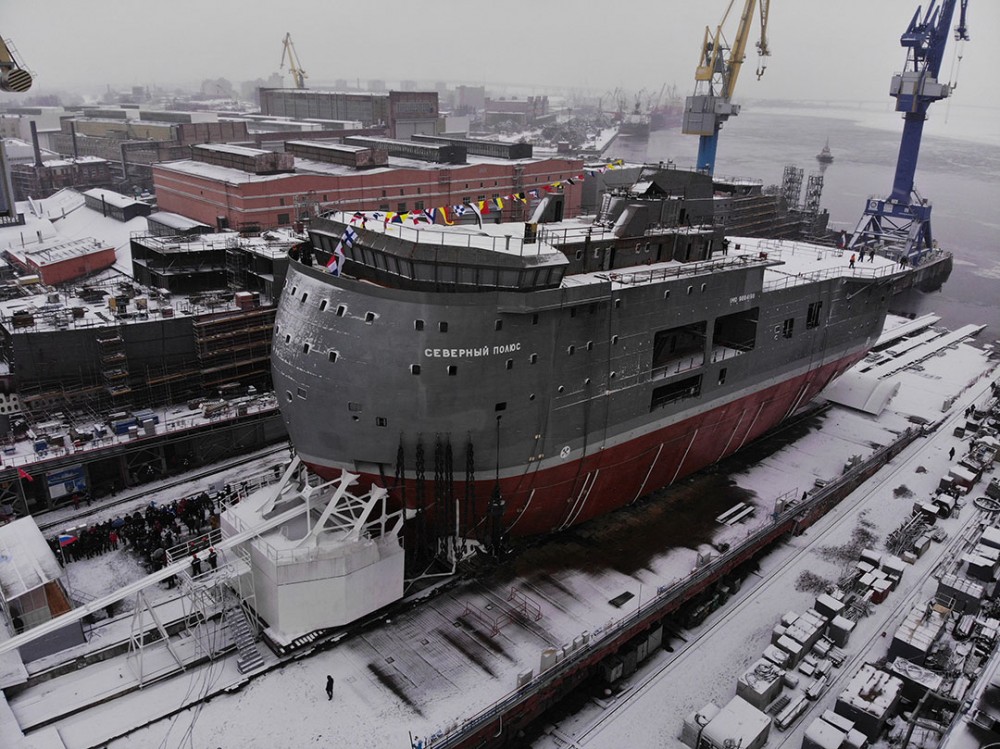Russian Arctic research in high spirits as yard sets the ‘North Pole’ research station afloat
The ship could stay in Arctic ice for long periods, replacing floating ice stations that have become increasingly difficult to establish.

As Russia prepares to the chairmanship of the Arctic Council, a unique Arctic research vessel is preparing to undertake its first voyage.
Hardly ever before has a ship with such a peculiar shape been rolled out of the Admiralty Yard in St. Petersburg. On December 18, the stout 83-meter-long vessel made it onto the waters of the Neva River. It is met with great expectation by Russia’s growing Arctic research community.
Among the attendees of the ceremony was Nataliya Radkova, Deputy Head of Roshydromet, the state meteorological service that it to operate the Severny Polyus (or “North Pole”). When the ship is ready for operation, presumably in 2022, the state organization will get at its disposal a unique tool for enhanced understanding of the Arctic.
“In order to provide high-quality prognosis we absolutely need constant data from the central parts of the Arctic. It is of great importance that researchers soon can get these data while staying onboard a ship in comfortable conditions and not in a tent on the ice,” the meteorological organization says in a statement.
The Severny Polyus will have 15 labs from where researchers can work year-round. It will be able to operate in the ice without icebreaker assistance and drift autonomously in remote Arctic waters for about two years.
But there is still a long way to go before the top Arc8 ice-class ship is ready to take onboard the researchers. At the moment, there is little more than the hull. The interior of the ship is now to be built, including the cabins, electric installations, navigation equipment, pipes and research laboratories, Roshydromet informs.
The floating research station is to be ready in 2022, that is during Russia’s two-year rotating chairmanship period.
More expensive
However, not everything has so far proceeded smoothly. The vessel was original to cost about €90 million, but the price is now believed to exceed €120 million.
The reported reason for the price hike is a series of substantial upgrades of the project requested by Roshydromet. Among those upgrades is an extension of the ship’s deadweight.
Furthermore, the project developers are believed to have encountered major technical challenges. Representatives of Russia’s United Shipbuilding Corporation confirmed to newspaper Kommersant that there are difficulties related to the vessel’s fuel system.
The Severny Polyus will house a crew of 14 and up to 34 researchers
The Russian Arctic and Antarctic Institute already 14 years ago proposed the construction of a permanent platform that would replace the annual drifting stations operated in Arctic waters.
“Since 1937, a total of 40 expeditions have been made, but because of the global warming and melting of the ice in the early 2000s we have been forced to halt the program,” institute Director Aleksandr Makarov said.
“The building of a self-propelled ice-protected platform allows us to continue the important studies of the Arctic Ocean at high altitudes,” he underlined.
Since 1937
The Soviet Union and later Russia has had floating research stations in the Arctic since 1937, with a break in the years 1991-2003.
In recent years, the research station has normally been established on an ice floe in September or October, and about two dozens of scientists would spend the winter there, measuring climate and weather conditions.
During the last couple of years, it has become more and more difficult to find ice floes solid enough to hold a station.
The last “real” ice station, “North Pole-40,” was established in October 2012, and had to be evacuated in May 2013, because the ice floe the base was placed on, started to break apart. The 16 scientists that had spent the winter on the floe had to be rescued by a nuclear-powered icebreaker sent out from Murmansk.
Russia did not set up any floating stations in 2013-2014 or in 2014-2015. In April 2015 they established a station called “North Pole 2015,” that only existed for four months.